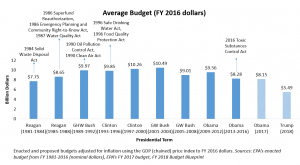
31 Percent Cut Would Undermine Enforcement of Clean Air and Clean Water Laws
Washington, D.C. – President Trump today proposed a budget for fiscal 2018 that would cut funding for the U.S. Environmental Protection Agency by nearly a third, eliminating more than 50 programs and crippling efforts to control and air and water pollution.
“President Trump’s proposed budget for EPA next year is an assault on public health and the environment,” said Eric Schaeffer, Executive Director of the Environmental Integrity Project. “It slashes support for clean air programs, scientific research, and enforcement – among other critical areas – and zeroes out funding completely for environmental justice and the Chesapeake Bay, Great Lakes and San Francisco Bay cleanups.”
“Congress should dump this proposal in the recycling bin and start over,” said Schaeffer, former Director of Civil Enforcement at EPA.
The proposed budget, titled “A New Foundation For American Greatness: Fiscal Year 2018,” was released today.
In real dollars, the proposal would leave EPA’s budget almost a third smaller than it was in President Ronald Reagan’s first term. The budget would eliminate about 25 percent of the EPA workforce (or almost 4,000 positions).
Although Trump and Congressional Republicans often claim that EPA has grown out of control in recent years, federal records show that the number of employees working at EPA has already been cut 16 percent since 1999, when the full-time employment ceiling reached its high point of 18,366 employees during the Clinton Administration.
Contrary to assertions that President Obama increased the size of EPA, in fact Obama trimmed the EPA workforce by nearly 11 percent, more than any other president, bringing the agency from 17,252 employees in fiscal year 2009 down to 15,376 in FY 2016, federal records indicate. Before that, President George W. Bush cut EPA’s workforce by 4 percent.
President Trump’s budget proposes reducing the EPA workforce of 15,400 by about 3,853 employees, or 25 percent.
Under Trump’s proposed budget, environmental enforcement would be cut by 19 percent.
“This is incredibly short-sighted,” said Schaeffer. “EPA’s enforcement pays for itself through actions that improve public health. Environmental enforcement also recovers cleanup costs and penalties from polluters who have broken the law.”
For example:
- EPA enforcement actions since 2000 have cut sulfur dioxide and nitrogen oxide pollution from power plants, refineries, autos and other major sources by 6.7 million tons, eliminating more than 20,000 premature deaths a year from heart and lung disease.
- Since 2003, EPA’s Superfund program has wrangled nearly $20 billion from responsible parties to clean up contaminated dumpsites and bring these abandoned properties back to life. That is far more than the agency spends on enforcement, and budget cuts will just stick taxpayers with the tab for these cleanups.
- Civil and criminal enforcement settlements since 2000 have required violators to commit nearly $150 billion to install scrubbers and other air pollution controls, upgrade sewage treatment plants, restore damaged watersheds, and take other actions to protect air and water quality. Violators have paid more than $6.4 billion in penalties to the U.S. Treasury or restitution to victims since 2000, more than offsetting the cost of maintaining these enforcement programs.
- In 2016, for example, civil enforcement by the agency was responsible for $13.7 billion in environmental projects and injunctive relief, as well as $1.4 billion in civil penalties. Criminal enforcement last year brought $207 million in restitution and fines, and $775,000 in court-ordered environmental projects.

Federal records show that the agency’s budget (now $8.1 billion) is about the same size today it was in the early 1980s under President Reagan, after adjusting for inflation. EPA’s budget grew slightly in the 1980s and 1990s, and has been shrinking since reaching a high during George W. Bush’s first term in office, 2001-2004. The proposed FY2018 budget of $5.7 billion would be the lowest budget in over a quarter century.
After adjusting for inflation, Trump’s proposal for 2018 would cut EPA’s budget 33 percent below last year’s spending levels and 44 percent below the average in President George W. Bush’s two terms.
The Environmental Integrity Project is a 15-year-old nonprofit, nonpartisan organization, based in Washington D.C., dedicated to enforcing environmental laws and holding polluters and governments accountable to protect public health.
Media contact: Tom Pelton, Environmental Integrity Project (443) 510-2574
###


